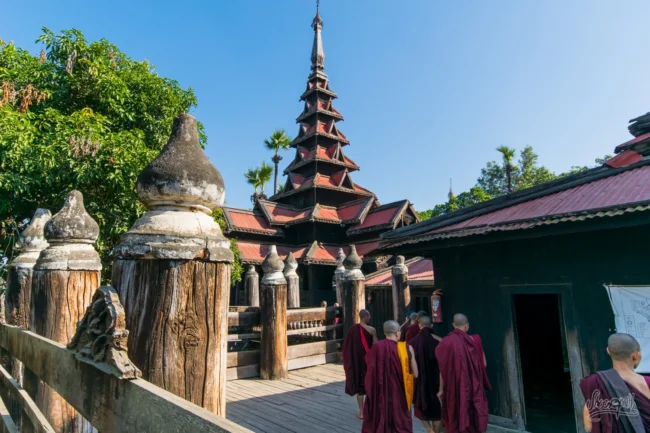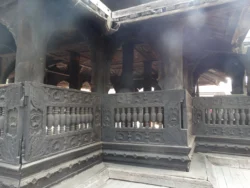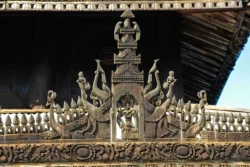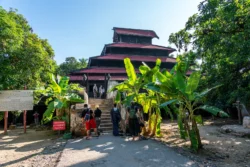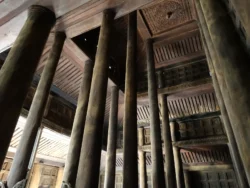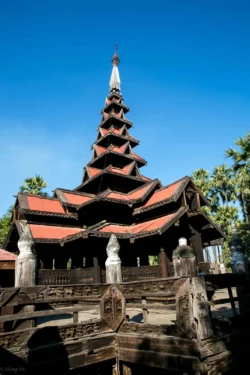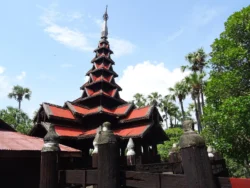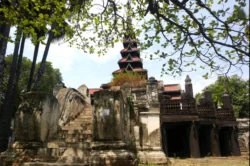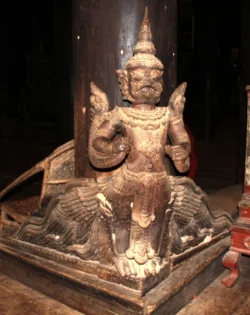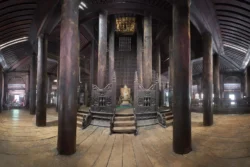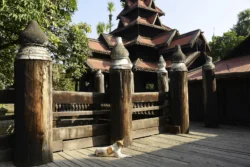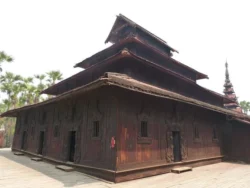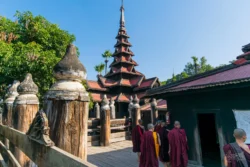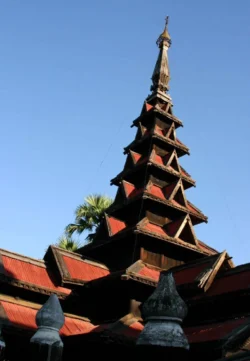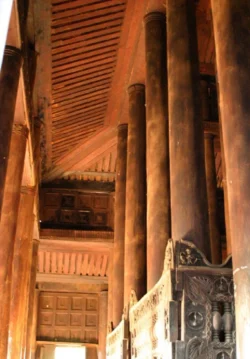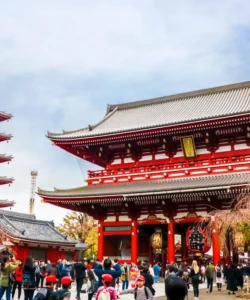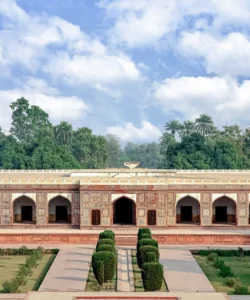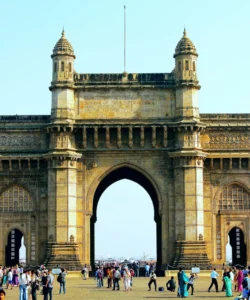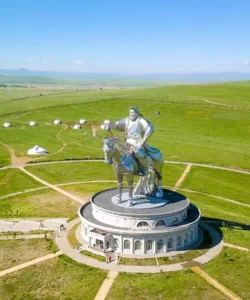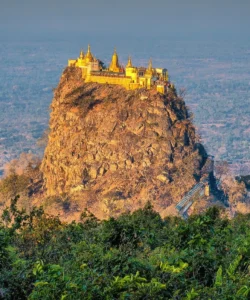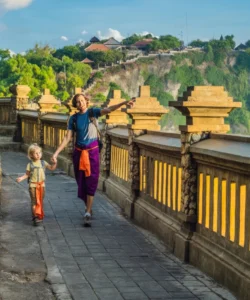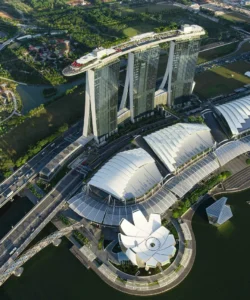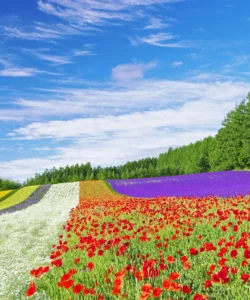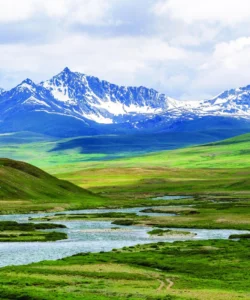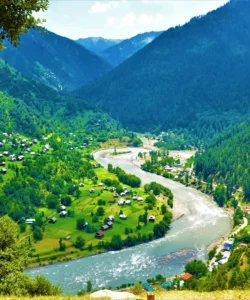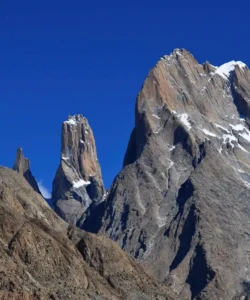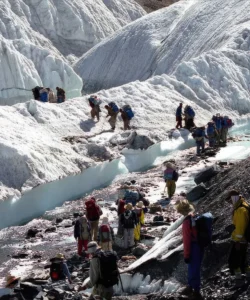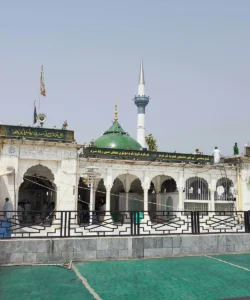The Bagaya Monastery, located in the ancient city of Inwa (Ava) near Mandalay, Myanmar, is a remarkable testament to traditional Burmese wooden architecture. It stands as one of Myanmar’s most cherished historical and spiritual sites, particularly famous for its intricate teak wood carvings and its enduring role as a monastic center.
Name: Bagaya Monastery (Burmese: ဘားဂရာ ကျောင်း; also Maha Waiyan Bontha Bagaya Monastery)
Address: Inwa, Mandalay Region, Myanmar. It is situated southwest of the former Inwa Palace, amidst wide paddy fields.
How to Get There:
Bagaya Monastery is located in Inwa, which is an ancient capital near Mandalay. Visiting usually involves a day trip from Mandalay.
- By Air: The closest airport is Mandalay International Airport (MDL). From Mandalay, you’ll need to travel to Inwa.
- From Mandalay to Inwa:
- By Taxi/Private Car: The most convenient option. The drive from Mandalay to the Inwa jetty takes about 30-45 minutes.
- By Ferry: The most popular way to reach Inwa is by taking a short ferry ride across the Ayeyarwady River from the Inwa jetty (often from Myitnge or Sagaing side).
- Within Inwa: Once you cross the river to Inwa, motorized vehicles are generally not allowed. The most common way to explore the ancient city and reach Bagaya Monastery is by:
- Horse Cart: Horse carts are readily available for hire at the ferry landing and provide a charming, traditional way to visit the various sites in Inwa, including Bagaya Monastery (about a 15-minute ride).
- Bicycle: Renting a bicycle is another option for independent exploration.
- Entrance Fee: There is an archaeological zone ticket required for entry into the Inwa area, which often includes access to Bagaya Monastery and other sites.
- Best Time to Visit: The dry season, from October to March, offers the most pleasant weather for exploring. Early morning or late afternoon visits are recommended for cooler temperatures and better light for photography.
Landscape and Architecture:
Bagaya Monastery is set amidst a tranquil rural landscape, and its architecture is a splendid example of traditional Burmese wooden monastic design, particularly its intricate teak wood craftsmanship.
- Teak Wood Construction: The monastery is constructed almost entirely from teak wood, a highly durable and prized hardwood native to Myanmar. This makes it a rare and valuable surviving example of traditional Burmese wooden architecture, which often suffered from fires or decay.
- Massive Teak Posts: The structure is supported by an impressive grid of 267 gigantic teak wood posts, some measuring up to 18 meters (60 feet) in height and 2.7 meters (9 feet) in circumference. These massive pillars elevate the entire building off the ground, protecting it from moisture and contributing to its grand scale.
- Traditional Monastic Layout: The monastery follows a traditional Burmese monastic design, typically laid out on an east-west axis. It includes various halls and sections for monastic life and worship. The central hall (Hsaung Maw Gyi) is particularly impressive, though often dimly lit, relying on natural light from open windows.
- Intricate Wood Carvings: Bagaya Monastery is famous for its exquisite and intricate wood carvings that adorn almost every surface – columns, beams, balustrades, doors, and windows. These carvings depict a rich array of Buddhist themes, floral motifs, mythological creatures (like Galon/Garuda, a mythical eagle/sunbird), and animals, showcasing the exceptional artistry of 19th-century Burmese craftsmen.
- Multi-Tiered Roof (Pyatthat): The monastery features a distinctive multi-tiered roof system, known as pyatthat, which rises in seven levels to a spire. This design is both symbolic (representing celestial levels) and functional (allowing hot air to rise and escape, aiding ventilation in the tropical climate). While the original beautiful wooden roof was replaced with corrugated iron after a fire in 1929, the tiered design remains.
- Rural Setting: The monastery stands in the middle of wide paddy fields, often surrounded by palms, banana trees, and thorny bushes, providing a picturesque and serene rural backdrop.
- Historical Resilience: Originally built in 1593 and later rebuilt in 1834 after a fire, its continued existence despite natural disasters (like earthquakes) and historical events highlights the resilience of its construction techniques, where primary columns rest on stone pedestals allowing independent movement during tremors.
What Makes It Famous:
- Exquisite Teak Wood Architecture: Bagaya Monastery is one of the most prominent and well-preserved examples of traditional Burmese teak wood monastic architecture, celebrated for its intricate wood carvings and the sheer scale of its timber construction.
- Massive Teak Pillars: The 267 huge teak posts supporting the entire structure are a famous engineering and aesthetic highlight, demonstrating the impressive use of this valuable material.
- Historical Significance in Inwa: It is one of the key surviving structures in Inwa (Ava), a former imperial capital of Myanmar for over six centuries, allowing visitors to glimpse the grandeur of a bygone era.
- Living Monastery and School: It remains an active Buddhist monastery and functions as a school for local monastic novices, offering a rare opportunity to observe daily monastic life and traditional Buddhist education.
- Architectural Artistry: The detailed wood carvings, depicting a rich array of Buddhist and cultural motifs, are considered masterpieces of 19th-century Burmese art.
- Photographic Beauty: Its rustic charm, intricate details, and serene rural setting make it a highly photogenic site, especially amidst the surrounding paddy fields.
Differences from Some Other Wonders:
- Solely Teak Wood Construction: While many ancient sites use stone (Angkor Wat, Borobudur) or a mix of stone and brick (Red Fort, Taj Mahal), Bagaya Monastery’s distinction is its almost entire construction from teak wood. This specialization in timber architecture sets it apart from other major historical monuments.
- Monastic Function: Unlike palaces (Mysuru Palace, Istana Nurul Iman) or temples primarily for public worship (Shwedagon Pagoda, Meenakshi Amman Temple), Bagaya Monastery is a functioning Buddhist monastery and educational center. This active monastic life and its role as a school for monks are integral to its identity.
- Intimate Scale Compared to Grand Complexes: While impressive in its timber construction, Bagaya Monastery is on a more intimate scale compared to the vast, sprawling stone temple complexes like Angkor Wat or Bagan, or the colossal urban monuments like the Shwedagon Pagoda. Its beauty lies in its intricate details and traditional setting rather than overwhelming size.
- Focus on Monastic Life and Wood Craftsmanship: It offers a specific cultural immersion into Burmese monastic traditions and a deep appreciation for the sophisticated art of traditional wood carving, which is a different emphasis than, for example, the scale of worship (Shwedagon) or the diverse array of temples (Bagan).
- Accessed by Horse Cart/Bicycle: The traditional mode of transport to reach it (horse cart) adds a unique, old-world charm to the visit that is not common for many other wonders.
- No Iconic Single Dome/Spire (like Shwedagon): While it has a multi-tiered roof, it lacks the single, massive, jewel-encrusted golden stupa/dome that makes Shwedagon or some of Brunei’s mosques instantly recognizable from afar. Its visual impact is experienced more up close.
Bagaya Monastery Photos:
